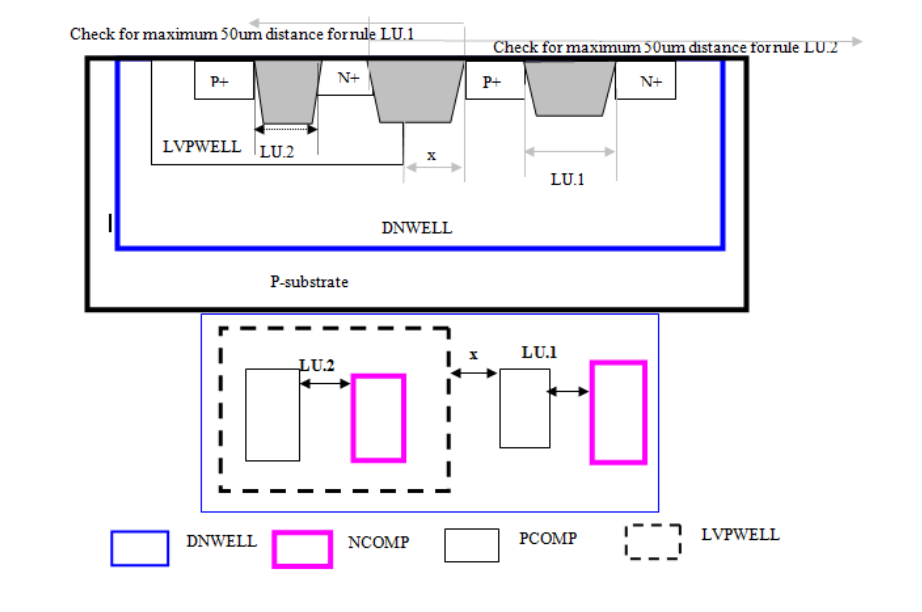14.3.1 Core Latch-up Rules and Guidelines¶
Critical design guidelines related to latch-up are N-well overlap of PCOMP, external NCOMP to Nwell spacing and Nwell to Psub tap distances.
RULE NO. |
DESCRIPTION |
LV |
MV |
Comment |
LU.1 |
FOR LV and MV inside DNWELL This rule is to check Max. Nwell/DNWELL tap space to every point on the boundary of PCOMP inside Nwell/DNWELL. For within 50um from (the PCOMP inside NWELL or DNWELL), minimum LVPWELL to (PCOMP outside LVPWELL) space is defined as (x): |
|||
a) If x >= 2.0um, then max Nwell/DNWELL tap space to every Point on the boundary of PCOMP inside NWELL/DNWELL |
50 |
15 |
Rule |
|
b) If x >= 1.0um and < 2um, then max Nwell/DNWELL tap space to every point on the boundary of PCOMP inside NWELL/DNWELL |
30 |
15 |
Rule |
|
c) If x < 1.0um, then max Nwell/DNWELL tap space to every point on the boundary of PCOMP inside NWELL/DNWELL |
15 |
15 |
Rule |
|
LU.2 |
FOR LV and MV inside DNWELL This rule is to check Max. LVPWELL tap space to every point on the boundary of NCOMP inside LVPWELL. For within 50um from (the NCOMP inside LVPWELL), minimum LVPWELL to (PCOMP outside LVPWELL) space is defined as x: |
|||
a) If x >= 2.0um, then Max. LVPWELL tap space to every point on the boundary of NCOMP inside LVPWELL. |
50 |
15 |
Rule |
|
b) If x >= 1.0um and < 2um, then Max. LVPWELL tap space to every point on the boundary of NCOMP inside LVPWELL. |
30 |
15 |
Rule |
|
c) If x <1.0um, then Max. LVPWELL tap space to every point on the boundary of NCOMP inside LVPWELL. |
15 |
15 |
Rule |
|
LU.3 |
FOR LV and MV outside DNWELL This rule is to check Max. LVPWELL (Psub) tap outside DNWELL space to every point on the boundary of NCOMP outside NWELL/DNWELL. For within 50um from the (NCOMP in LVPWELL or Psub), Minimum NWELL to (NCOMP outside Nwell) space is defined as y. |
|||
a) If y >= 2.0um, then Max. LVPWELL (Psub) tap outside DNWELL space to every point on the boundary of NCOMP outside NWELL/DNWELL. |
50 |
15 |
Rule |
|
b) If y >= 1.0um and < 2.0um, then Max. LVPWELL (Psub) tap outside DNWELL space to every point on the boundary of NCOMP outside NWELL/DNWELL. |
30 |
15 |
Rule |
|
c) If y <1.0um, then Max. LVPWELL (Psub) tap outside DNWELL space to every point on the boundary of NCOMP outside NWELL/DNWELL. |
15 |
15 |
Rule |
|
LU.4 |
FOR LV and MV outside DNWELL This rule is to check Max. Nwell tap space to every point on the boundary of PCOMP inside Nwell. For within 50um from (the PCOMP inside NWELL), minimum NWELL to (NCOMP outside Nwell) space is defined as y: |
|||
a) If y >= 2.0um, then Max. Nwell tap space to every point on the boundary of PCOMP inside Nwell |
50 |
15 |
Rule |
|
b) If y >= 1.0um and < 2um, then Max. Nwell tap space to every point on the boundary of PCOMP inside Nwell |
30 |
15 |
Rule |
|
c) If y < 1.0um, then Max. Nwell tap space to every point on the boundary of PCOMP inside Nwell |
15 |
15 |
Rule |
|
For Native Vt NMOS (check for NAT marking) |
||||
LU.5 |
For within 50um from NAT layer, If there is NWELL present, then NAT layer shall be directly surrounded by PCOMP substrate guard ring. (No other NCOMP, NWELL in between the NAT and PCOMP guard ring) |
Rule |
||
Common Guidelines |
||||
LU.7* |
Maximize the number of contacts in the substrate and well taps. |
– |
– |
Guideline |
Total equivalent contact area to the channel area generating substrate current (Poly2 intersecting COMP) should be more than 3%. This is a guideline only. |
||||
LU.8* |
Butted substrate contact to source is always the best for latch-up immunity wherever possible |
– |
– |
Guideline |
LU.9* |
All Nwell taps shall be connected to respective most highest Potential |
– |
– |
Guideline |
LU.10* |
All Psub shall be connected to their respective lowest potential |
– |
– |
Guideline |
Note

